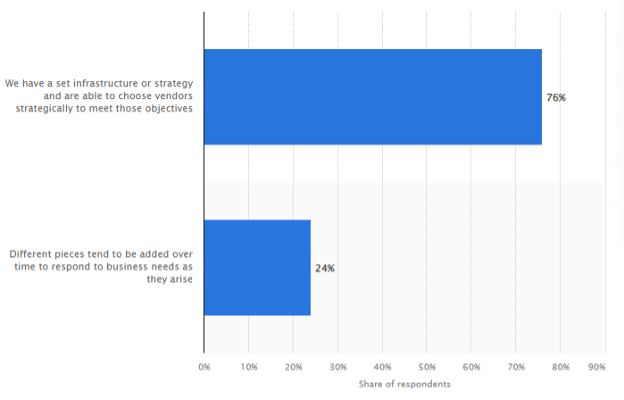Agility, scalability, and cost-efficiency are more important today than ever before. As a result, hybrid cloud has emerged as a game-changing IT strategy. In 2022, 76% of companies reported that they had a plan to incorporate hybrid cloud technology and were ready to implement it.

By 2023, Azure and AWS were considered to be the leading hybrid cloud providers with a majority using these two.

However, 9% organizations were considering to use Google Cloud Platform and IBM Cloud for this. By H2 of 2023, more than 90% companies were either experimenting or already had a hybrid cloud platform integrated into their workflow.
This is because combining the strengths of on-premises infrastructure with the flexibility of cloud resources, hybrid cloud offers a versatile solution for organizations seeking to maximize their IT capabilities.
This article delves into the nuances of hybrid cloud integration, discussing strategies, best practices, and the benefits of blending on-premises and cloud resources. It aims to provide CIOs with valuable insights on how to seamlessly connect and manage diverse cloud environments while optimizing performance and cost-efficiency.
The Hybrid Cloud Landscape
Before we dive into strategies and best practices, it’s essential to understand the hybrid cloud landscape. In a hybrid cloud environment, organizations leverage a mix of on-premises data centers, private clouds, and public cloud services. This amalgamation allows for greater flexibility in deploying workloads, applications, and services, aligning IT resources with specific business needs.
Key Components of Hybrid Cloud:
- On-Premises Infrastructure: This includes an organization’s traditional data centers, servers, and networking equipment, often hosting critical applications and sensitive data.
- Private Cloud: A private cloud is an infrastructure dedicated to a single organization. It offers control, security, and customization, making it suitable for mission-critical workloads.
- Public Cloud: Public cloud services, provided by major vendors like AWS, Azure, and Google Cloud, offer on-demand computing resources, scalability, and a pay-as-you-go pricing model.
- Hybrid Cloud Management: A centralized management layer that writes and integrates on-premises and cloud resources, ensuring seamless operations.
Strategies for Effective Hybrid Cloud Integration
Unlocking the full potential of hybrid cloud necessitates a well-thought-out integration strategy. Here are key strategies to consider:
1. Assess Your Workloads
Begin by conducting a thorough assessment of your workloads. Not all applications are created equal, and some are better suited for specific environments. Critical factors to evaluate include performance requirements, data sensitivity, compliance, and scalability. This assessment will guide you in determining which workloads should run on-premises, in the private cloud, or in the public cloud.
To effectively assess workloads, consider implementing a workload placement strategy based on factors such as data residency requirements, latency sensitivity, and regulatory compliance. For instance, mission-critical applications with stringent security and compliance needs may be better suited for a private cloud, while development and testing environments can leverage the cost-efficiency of the public cloud.
Challenges: The complexity of assessing and categorizing workloads can be daunting. It requires a deep understanding of application requirements and dependencies, as well as a comprehensive view of data governance policies.
2. Embrace Cloud-Native Technologies
To fully leverage the benefits of hybrid cloud, embrace cloud-native technologies. These are tools and practices designed for cloud environments. Containers, microservices, and serverless computing are examples of cloud-native technologies that enhance portability and scalability across hybrid environments.
Adopting cloud-native technologies facilitates workload portability across different cloud environments. Containers, for example, enable applications to run consistently across on-premises and cloud infrastructure. This approach simplifies management and accelerates deployment.
Challenges: Embracing cloud-native technologies requires upskilling your IT teams and ensuring they have the expertise to effectively manage and operate these technologies. Additionally, legacy applications may need significant refactoring to become cloud-native.
3. Implement a Robust Management Solution
Centralized management is the linchpin of hybrid cloud success. Invest in a management solution that provides a unified view of your hybrid infrastructure. This allows you to monitor performance, automate tasks, optimize resource allocation, and ensure security and compliance across all environments.
Consider implementing a cloud management platform (CMP) that offers a single pane of glass for managing workloads, monitoring performance, and optimizing costs across your hybrid cloud. A CMP can help you enforce policies, automate provisioning, and ensure governance.
Challenges: Integrating a management solution across diverse environments can be challenging. It requires careful planning and coordination to ensure seamless communication between on-premises and cloud components.
4. Prioritize Security
Security should be a top priority in any hybrid cloud strategy. Implement encryption, identity and access management, and security policies consistently across all environments. Regularly audit and update security measures to adapt to evolving threats.
Leverage security services provided by your cloud providers, such as AWS Identity and Access Management (IAM) or Azure Active Directory. These services offer robust identity management and access control capabilities. Additionally, consider implementing a zero-trust security model, which assumes that threats can come from anywhere, including within your network.
Challenges: Ensuring consistent security across hybrid environments requires careful configuration and ongoing monitoring. Security policies and access controls must be aligned across on-premises and cloud environments.
5. Optimize Costs
One of the significant advantages of hybrid cloud is cost optimization. Leverage cost analysis tools to identify opportunities for resource consolidation, rightsizing, and workload placement. Implement a well-defined cost governance strategy to avoid unexpected expenses.
Use cost optimization tools provided by cloud vendors to gain visibility into your spending patterns. Implement budget controls and automated alerts to prevent cost overruns. Regularly review your usage and adjust resources accordingly.
Challenges: Cost optimization in a hybrid cloud environment can be complex due to the variability of costs across different cloud providers and on-premises infrastructure. It requires ongoing monitoring and adjustment to ensure cost efficiency.
Best Practices for Seamless Hybrid Cloud Management
Beyond these strategies, adopting best practices is essential for seamless hybrid cloud management:
1. Automation
Implement automation for provisioning, scaling, and workload orchestration. Automation streamlines operations, reduces human errors, and enhances scalability. Consider implementing infrastructure as code (IAC) to define and provision resources through code. This approach enables consistent and repeatable deployments across hybrid environments.
Challenges: Implementing automation requires careful planning and testing to ensure it aligns with your organization’s processes and policies.
2. Monitoring & Analytics
Leverage monitoring tools and analytics to gain insights into the performance and health of your hybrid infrastructure. Real-time data empowers proactive decision-making and issue resolution. Implement a robust monitoring and analytics solution that provides visibility into the entire hybrid environment, including on-premises and cloud resources.
Consider utilizing machine learning and AI-driven analytics to predict and prevent issues. If needed CIOs can also collaborate with other department heads or even the CEO to get a better grasp on the business’ key metrics.
Challenges: Managing and analyzing data from diverse sources can be challenging. It requires integration between monitoring tools and the ability to correlate data for meaningful insights.
3. Disaster Recovery & Business Continuity
Craft a comprehensive disaster recovery and business continuity plan that spans all cloud environments. Regularly test these plans to ensure readiness. Implement a multi-cloud disaster recovery strategy that replicates critical workloads and data to multiple cloud providers. This approach ensures redundancy and resilience.
Challenges: Coordinating disaster recovery plans across hybrid environments can be complex. It requires careful coordination and testing to ensure failover and failback processes work seamlessly.
4. Compliance & Governance
Maintain strict compliance and governance standards across all environments. Implement policies, controls, and auditing mechanisms to meet regulatory requirements.
Leverage compliance management tools that provide automated checks and reports to demonstrate adherence to compliance standards. Implement a governance framework that includes policies, roles, and responsibilities for managing hybrid cloud resources.
Challenges: Compliance requirements can vary across industries and regions. Ensuring consistent compliance across hybrid environments requires ongoing monitoring and documentation.
5. Training, Retention, & Skill Development
Invest in training and skill development for your IT teams. Ensuring your staff is well-versed in hybrid cloud technologies is essential for successful implementation and management. Furthermore, it is not only important to hire talent, but also to make sure that you are able to retain it.
Provide training and certification opportunities for your IT staff to enhance their cloud skills. Provide upskilling opportunities, as well as room to grow. Encourage cross-training between on-premises and cloud technologies to foster a hybrid cloud-ready workforce.
Challenges: Upskilling your IT teams can be a time-consuming process. It requires a commitment to ongoing training and skill development.
CIOs Should Harness the Power of Hybrid Cloud
Hybrid cloud is not merely a transitional strategy; it’s a destination in itself, offering the best of both on-premises and cloud worlds. By assessing workloads, embracing cloud-native technologies, and implementing robust management and security measures, organizations can unlock the full potential of hybrid cloud integration.
As CIOs navigate the evolving IT landscape, understanding and harnessing the power of hybrid cloud is a strategic imperative that can drive efficiency, agility, and innovation.
Additional Hybrid Cloud Resources
The CIOs Guide to Hybrid Cloud
Managing Cloud Sprawl: Strategies for IT Executives to Optimize Cloud Resources
Cloud Discovery and Assessment Guide
Comparing Hybrid Cloud and Multi-Cloud Solutions For Your Business



0 Comments